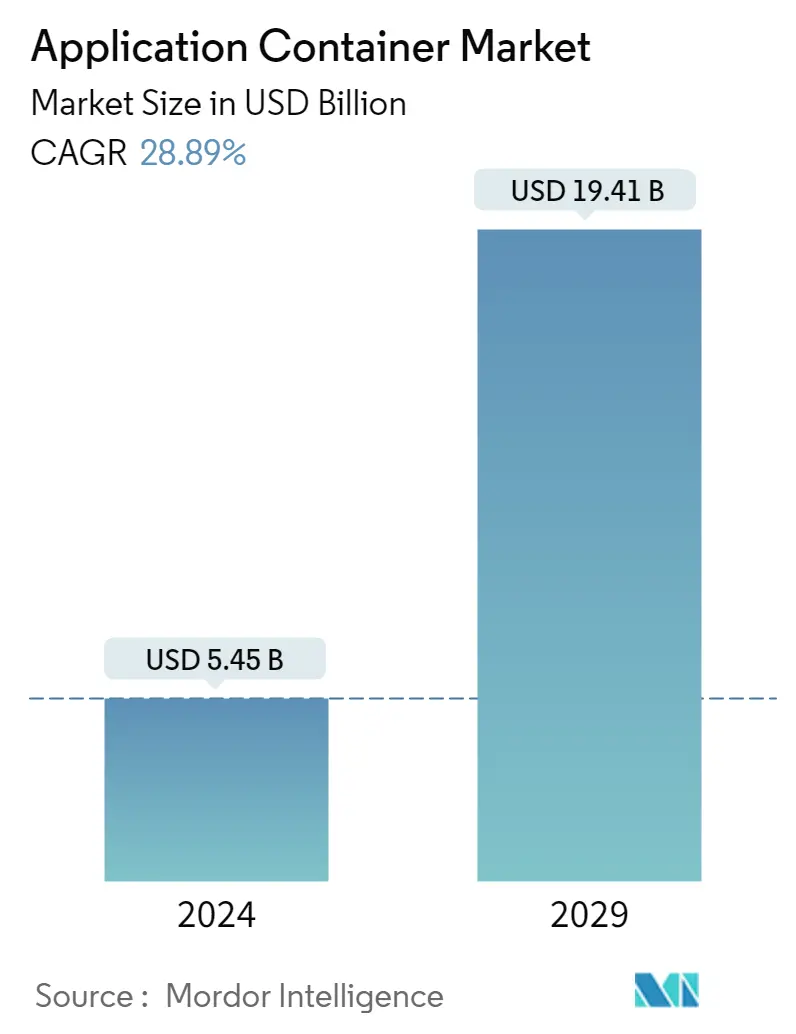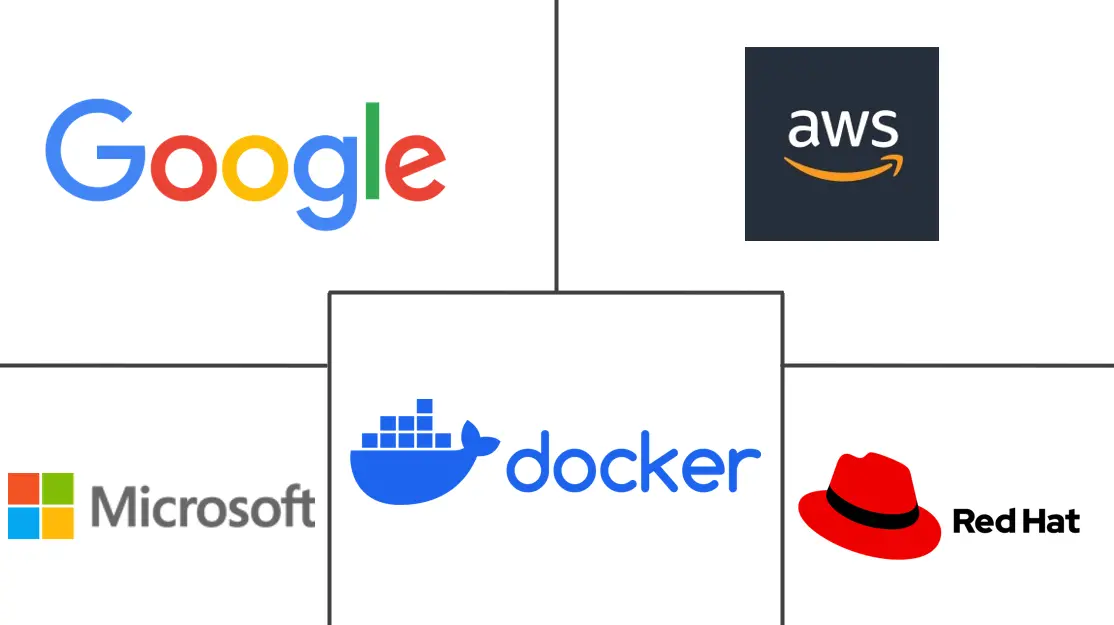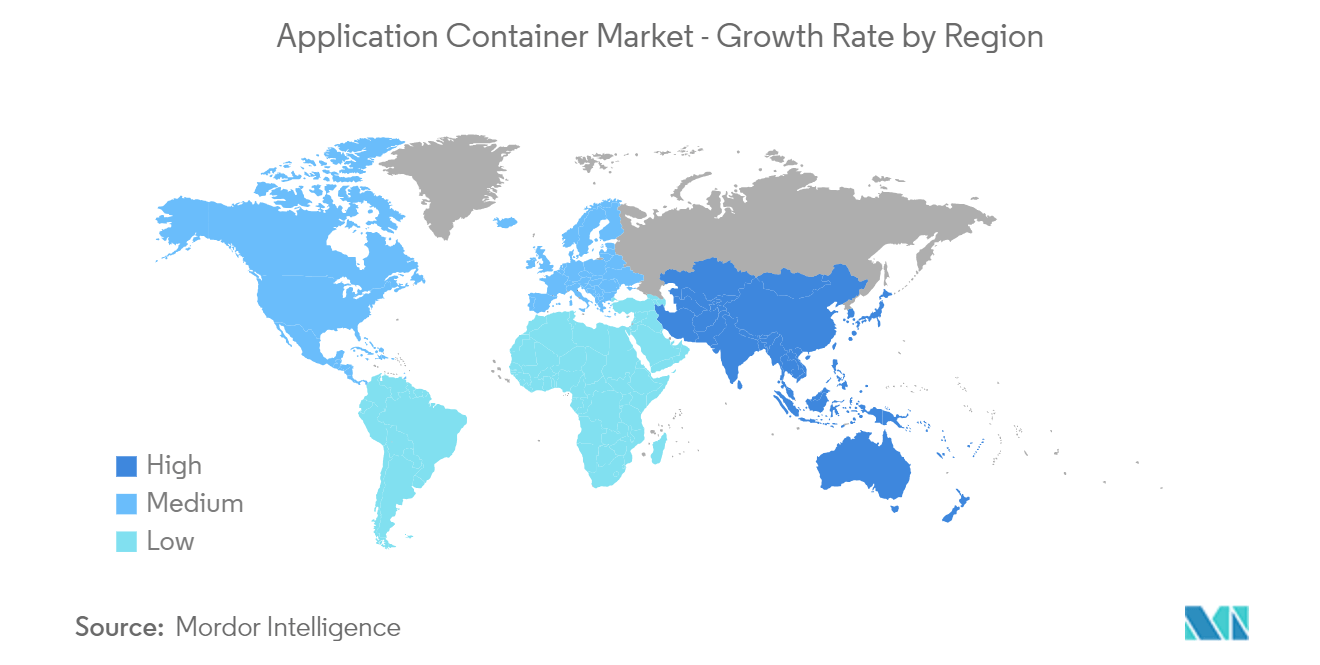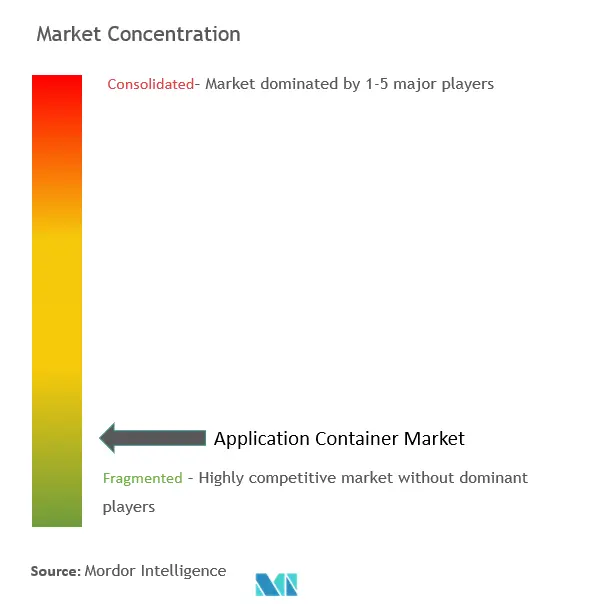Application Container Market Size

| Study Period | 2019 - 2029 |
| Market Size (2024) | USD 5.45 Billion |
| Market Size (2029) | USD 19.41 Billion |
| CAGR (2024 - 2029) | 28.89 % |
| Fastest Growing Market | Asia Pacific |
| Largest Market | North America |
Major Players
*Disclaimer: Major Players sorted in no particular order |
Application Container Market Analysis
The Application Container Market size is estimated at USD 5.45 billion in 2024, and is expected to reach USD 19.41 billion by 2029, growing at a CAGR of 28.89% during the forecast period (2024-2029).
The market is anticipated to witness a steady rise in the number of containerized applications as businesses deploy their applications using containers on a regular basis. The numerous advantages of containers, such as their simplicity in packaging and deploying programs, their capacity to execute the same application across multiple environments, and their rapid and effective scalability, will be the driving force behind this movement. Moreover, the CNCF's 2022 study found that 44% of participants utilize containers for most or all production applications. Kubernetes is used to deploy at least some containers in production by half of those that utilize containers.
- The application container market has witnessed substantial growth and transformation in recent years. Application containers have become a critical technology in software development and deployment, offering a lightweight and efficient way to package, deploy, and manage applications. Several notable trends have driven the application container market in recent years. One of the most prominent trends is the adoption of hybrid and multi-cloud strategies. Organizations are increasingly leveraging containers to achieve flexibility and portability across diverse cloud providers and on-premises infrastructure, thus reducing vendor lock-in and enhancing adaptability to changing needs.
- Many organizations are leveraging containers to modernize their legacy apps, streamline infrastructure, and to be able to market their innovations faster. Containers primarily help speed up the applications to market because they offer faster, more consistent release cycles. The application is therefore developed in a container, packaged, tested, and deployed into production. As the application is already being tested in a runtime environment, there is no need for additional testing. Also, much less troubleshooting is required as containers are built to restart when they detect a failure.
- Several factors drive the application container market. Efficiency and portability are key drivers, as containers provide a consistent and efficient way to package applications, reducing compatibility issues and ensuring portability across different environments. Scalability is another critical driver, allowing organizations to adjust to varying workloads rapidly and user demands while optimizing resource utilization and reducing costs. The alignment of containers with DevOps and Agile methodologies promotes rapid development and deployment, enhancing an organization's competitiveness in a dynamic marketplace.
- Moreover, In October 2023, Sysdig and Docker announced the integration of Sysdig runtime insights into Docker Scout inorder to help developers prioritize risk and move faster. Docker and Sysdig will help customers reduce software supply chain noise, prioritize the insights that matter, and build leaner container images. Sysdig is the first runtime security integration into Docker Scout.
- However, containers can be more vulnerable to certain security risks, such as kernel exploits and shared resources vulnerabilities. Organizations are looking to implement robust security measures, and misconfigurations or supervised security practices can lead to significant security breaches. Also, managing containers at scale can be complex, especially in large enterprise environments. Organizations are expected to implement container orchestration tools like Kubernetes, including networking, storage, and other infrastructure components, which can introduce complexity and require specialized expertise.
- The COVID-19 pandemic imposed remote working scenarios, which have highlighted the importance of the cloud for business continuity with remote workforces and smooth online communication. Any enterprise's journey toward cloud transformation includes a container strategy. Numerous businesses adopted a container-first strategy because of the flexibility and cost savings that application containers provide, which is creating a demand for the market in the post-pandemic phase.
Application Container Market Trends
Efficient and Portable Characteristics of Application Containers to Drive the Market Growth
- Containerized applications are highly portable. Developers can create a container image containing the application and its dependencies, which can then be deployed on various platforms and cloud providers with minimal adjustments. This portability simplifies application migration, reducing the complexities associated with moving software between different environments.
- The portability aspect of containers further drives market growth. Containerized applications are highly transportable, allowing developers to create a container image that encapsulates the application and its dependencies. This image can be effortlessly deployed across various platforms and cloud providers with minimal adjustments. This ease of portability simplifies application migration, streamlining the process and mitigating complexities associated with shifting software between different environments.
- Moreover, ionir, a container-native data services provider for Kubernetes, conducted a survey. According to findings, around 63 percent of survey participants believed enhanced mobility and agility were the primary reasons for migrating applications inside containers in 2022. These characteristics give organizations the mobility and agility to respond rapidly to dynamic market conditions, meet evolving customer needs, and maintain a competitive edge.
- Further, the alignment of containers with DevOps and Agile practices is another significant benefit. Containers facilitate collaboration, automation, and the adoption of continuous integration and continuous deployment (CI/CD) methodologies. Development teams can iterate, test, and deploy containerized applications rapidly, supporting agile development cycles and improved product quality.
- Additionally, cost reduction is a consequent outcome of container adoption. By optimizing resource utilization and enabling efficient scaling, containers contribute to cost savings. This financial benefit extends to both infrastructure resources and cloud services, making containers an appealing choice for organizations looking to enhance cost efficiency.

North America is Expected to Hold a Significant Market Share
- The North American region is expected to occupy a significant share in the market owing to various factors, such as the gaining momentum of enterprises in microservices architecture and the ongoing transformation of existing business-critical applications that are driving the growth of the market. The continuous increase in financial investments in container technology and the presence of a large number of small and large players in this region are expected to present many opportunities for market expansion shortly.
- The North American region has rapidly adopted cloud and related services. The region has an extensive cloud network established by major cloud service providers in this region, which is one of the primary factors fueling the growth of the market. Moreover, this region's increased demand for DevOps has significantly contributed to market growth.
- Further, the region is home to various startups that provide application container solutions, including Bluedata, ClusterHQ, CoreOS, Docker, Sysdig, Twistlock, etc. Multiple standards/guidelines for securing the containerized infrastructure are emerging in the region.
- Organizations in the region are primarily adopting containers to accelerate their software delivery and embrace flexibility in their production environment while moving to the cloud. NIST, a division of the US Department of Commerce, has introduced guidelines that recommend that organizations transform their operational culture and technical processes to support this new way of developing, running, and supporting applications made possible by containerization.
- Many companies are developing security solutions for application Containers to increase the reliability and trust of the application container technology in the region, which is driving the adoption of the market in North America. For instance, in October 2022, Veracode, a supplier of application security testing solutions, announced the addition of container security to its Continuous Software Security Platform. The new Veracode Container Security service solved the need for vulnerability scanning, secure configuration, and secrets management for container images. It was created to satisfy the needs of cloud-native software engineering teams.

Application Container Industry Overview
The application container market is highly competitive, owing to the presence of many small and large players operating in domestic and international markets. The market appears to be fragmented, with significant players adopting strategies like product innovation, and the emergence of various start-up companies is marking the market dynamic. Some of the market's major players are Amazon Web Services, Inc., Google LLC, and Microsoft Corporation.
In May 2023, Kyndryl, a global IT infrastructure services provider, announced introducing new services and capabilities to support Red Hat OpenShift clients in improving and expanding their capacity to consistently update and transfer essential business applications to hybrid cloud environments. By automating application modernization with new services, Kyndryl's new integrated services and capabilities, which are part of a broader comprehensive set of container management and security capabilities, are intended to assist clients in accelerating their cloud transformation ambitions.
In December 2022, Red Hat OpenShift certification for Red Hat Enterprise Linux was made available to DH2i's DxEnterprise multi-platform smart clustering software. With this certification, Red Hat OpenShift and Red Hat Enterprise Linux could confirm that the company’s containerized solution would accelerate the development of intelligent applications across hybrid and multi-cloud environments. Red Hat OpenShift and DxEnterprise could be used to create lightweight execution environments for applications, enabling enterprises to deploy essential workloads across physical, virtual, private, and public cloud and edge environments more quickly and consistently.
Application Container Market Leaders
-
Amazon Web Services Inc. (Amazon.com, Inc.)
-
Google LLC (Alphabet Inc.)
-
Microsoft Corporation
-
Red Hat Inc. (IBM Corporation)
-
Docker Inc. (Mirantis, Inc.)
*Disclaimer: Major Players sorted in no particular order

Application Container Market News
- January 2023: Landis+Gyr, a global company in energy management systems, and MicroEJ, the supplier of software containers for IoT and embedded devices, announced their partnership to improve the app development environment for the following generation of smart meters. This partnership would set the digital groundwork for more effective and environmentally friendly energy management.
- October 2022: Oracle introduced to offer of serverless Kubernetes container management. Enterprises struggle to build and operate cloud-native apps efficiently, but by using Oracle Container Engine for Kubernetes Virtual Nodes infrastructure, companies could build applications more easily. Additionally, Virtual Nodes enable customers to deliver trustworthy Kubernetes operations at scale without maintaining any infrastructure.
Application Container Market Report - Table of Contents
1. INTRODUCTION
- 1.1 Study Assumptions and Market Definition
- 1.2 Scope of the Study
2. RESEARCH METHODOLOGY
3. EXECUTIVE SUMMARY
4. MARKET INSIGHTS
- 4.1 Market Overview
- 4.2 Industry Value Chain Analysis
-
4.3 Industry Attractiveness - Porter's Five Force Analysis
- 4.3.1 Bargaining Power of Suppliers
- 4.3.2 Bargaining Power of Buyers/Consumers
- 4.3.3 Threat of New Entrants
- 4.3.4 Threat of Substitute Products
- 4.3.5 Intensity of Competitive Rivalry
- 4.4 Assessment of the Impact of COVID-19 on the Market
5. MARKET DYNAMICS
-
5.1 Market Drivers
- 5.1.1 Efficient and Portable Characteristics of Application Containers to Drive the Market Growth
- 5.1.2 Rising Shift Towards Cloud-native Application Development
-
5.2 Market Restraints
- 5.2.1 Security Risks Associated With the Technology
- 5.2.2 Proliferation of Container Sprawl
-
5.3 Major Container Use-case Areas
- 5.3.1 Management and Orchestration
- 5.3.2 Monitoring
- 5.3.3 DevOps
- 5.3.4 Security
- 5.3.5 Networking
- 5.3.6 Storage
6. MARKET SEGMENTATION
-
6.1 By Deployment Type
- 6.1.1 On-Premises
- 6.1.2 Cloud
-
6.2 By Organization Size
- 6.2.1 Small and Medium Enterprises (SMEs)
- 6.2.2 Large Enterprises
-
6.3 By Service
- 6.3.1 Container Monitoring & Security
- 6.3.2 Container Data Management & Orchestration
- 6.3.3 Container Networking
- 6.3.4 Container Support & Maintenance
- 6.3.5 Other Services
-
6.4 By Industry Vertical
- 6.4.1 BFSI
- 6.4.2 Healthcare and life science
- 6.4.3 Telecommunication and IT
- 6.4.4 Retail and e-commerce
- 6.4.5 Education
- 6.4.6 Media and entertainment
- 6.4.7 Others (manufacturing, utilities, transportation and logistics, travel and hospitality, and government)
-
6.5 By Geography
- 6.5.1 North America
- 6.5.1.1 United States
- 6.5.1.2 Canada
- 6.5.2 Europe
- 6.5.2.1 United Kingdom
- 6.5.2.2 Germany
- 6.5.2.3 France
- 6.5.2.4 Spain
- 6.5.2.5 Rest of Europe
- 6.5.3 Asia-Pacific
- 6.5.3.1 China
- 6.5.3.2 India
- 6.5.3.3 Japan
- 6.5.3.4 Rest of Asia-Pacific
- 6.5.4 Latin America
- 6.5.4.1 Brazil
- 6.5.4.2 Argentina
- 6.5.4.3 Mexico
- 6.5.4.4 Rest of Latin America
- 6.5.5 Middle East and Africa
- 6.5.5.1 United Arab Emirates
- 6.5.5.2 Saudi Arabia
- 6.5.5.3 South Africa
- 6.5.5.4 Rest of Middle East and Africa
7. COMPETITIVE LANDSCAPE
-
7.1 Company Profiles
- 7.1.1 Amazon Web Services Inc. (Amazon.com, Inc.)
- 7.1.2 Google LLC (Alphabet Inc.)
- 7.1.3 Microsoft Corporation
- 7.1.4 Oracle Corporation
- 7.1.5 Red Hat Inc. (IBM Corporation)
- 7.1.6 Docker Inc. (Mirantis, Inc.)
- 7.1.7 Engine Yard Inc. (Crossover Corporate Group)
- 7.1.8 Joyent Inc. (Samsung Corporation)
- 7.1.9 Heroku Services (Salesforce, Inc.)
- 7.1.10 VMware, Inc. (Broadcom, Inc.)
- *List Not Exhaustive
8. INVESTMENT ANALYSIS
9. MARKET OPPORTUNITIES AND FUTURE TRENDS
** Subject To AvailablityApplication Container Industry Segmentation
The Application Container is a standard unit of software that packages up code and all its dependencies so that the applications run quickly and reliably from one computing environment to another. Application containers consume fewer resources than a comparable deployment on virtual machines because containers share resources without a full operating system to underpin each app. Containers are software packages that come with everything needed to execute in any environment. Containers virtualize the operating system in this manner, enabling them to run anywhere, even on a developer's personal laptop or on a public cloud.
Application container market is segmented by deployment type (on-premises, cloud), organization size (small and medium enterprises [SMEs], large enterprises), service (container monitoring & security, container data management & orchestration, container networking, container support & maintenance), industry vertical (BFSI, healthcare and life science, telecommunication and IT, retail and e-commerce, education, media and entertainment) and geography (North America (United States, Canada), Europe (United Kingdom, Germany, France, Spain, Rest of Europe), Asia-Pacific (China, India, Japan, Rest of Asia-Pacific), Latin America (Brazil, Argentina, Mexico, Rest of Latin America), Middle East and Africa (United Arab Emirates, Saudi Arabia, South Africa, Rest of Middle East and Africa)).The market sizes and forecasts are provided in terms of value in USD for all the above segments.
| By Deployment Type | On-Premises | |
| Cloud | ||
| By Organization Size | Small and Medium Enterprises (SMEs) | |
| Large Enterprises | ||
| By Service | Container Monitoring & Security | |
| Container Data Management & Orchestration | ||
| Container Networking | ||
| Container Support & Maintenance | ||
| Other Services | ||
| By Industry Vertical | BFSI | |
| Healthcare and life science | ||
| Telecommunication and IT | ||
| Retail and e-commerce | ||
| Education | ||
| Media and entertainment | ||
| Others (manufacturing, utilities, transportation and logistics, travel and hospitality, and government) | ||
| By Geography | North America | United States |
| Canada | ||
| By Geography | Europe | United Kingdom |
| Germany | ||
| France | ||
| Spain | ||
| Rest of Europe | ||
| By Geography | Asia-Pacific | China |
| India | ||
| Japan | ||
| Rest of Asia-Pacific | ||
| By Geography | Latin America | Brazil |
| Argentina | ||
| Mexico | ||
| Rest of Latin America | ||
| By Geography | Middle East and Africa | United Arab Emirates |
| Saudi Arabia | ||
| South Africa | ||
| Rest of Middle East and Africa |
Application Container Market Research Faqs
How big is the Application Container Market?
The Application Container Market size is expected to reach USD 5.45 billion in 2024 and grow at a CAGR of 28.89% to reach USD 19.41 billion by 2029.
What is the current Application Container Market size?
In 2024, the Application Container Market size is expected to reach USD 5.45 billion.
Who are the key players in Application Container Market?
Amazon Web Services Inc. (Amazon.com, Inc.), Google LLC (Alphabet Inc.), Microsoft Corporation, Red Hat Inc. (IBM Corporation) and Docker Inc. (Mirantis, Inc.) are the major companies operating in the Application Container Market.
Which is the fastest growing region in Application Container Market?
Asia Pacific is estimated to grow at the highest CAGR over the forecast period (2024-2029).
Which region has the biggest share in Application Container Market?
In 2024, the North America accounts for the largest market share in Application Container Market.
What years does this Application Container Market cover, and what was the market size in 2023?
In 2023, the Application Container Market size was estimated at USD 4.23 billion. The report covers the Application Container Market historical market size for years: 2019, 2020, 2021, 2022 and 2023. The report also forecasts the Application Container Market size for years: 2024, 2025, 2026, 2027, 2028 and 2029.
Application Container Industry Report
Statistics for the 2024 Application Container market share, size and revenue growth rate, created by Mordor Intelligence™ Industry Reports. Application Container analysis includes a market forecast outlook to for 2024 to 2029 and historical overview. Get a sample of this industry analysis as a free report PDF download.



